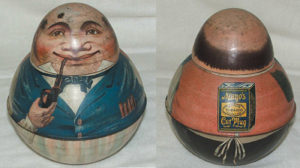
We had one correct answer to our December’s What Is It. Bill McLaren of Anchorage, Alaska correctly identified the item. He says, “The picture shows the front and back of a roly poly tobacco tin advertising Mayo’s Cut Plug Tobacco, probably early 20th Century, head lifts off.” Bill is right! He wins a year subscription to the Mountain States Collector. Congratulations!
Advertising tins in every category from cookies to tobacco are finding buyers willing to pay from a few dollars to over $200. It doesn’t seem to matter whether the art work is mundane or colorful. Age and rarity can make a price difference as well as the popularity of the category. Even 1970s reproductions of a rare antique tin, such as the Roly Poly tobacco tins can sell for up to $100. Certain original Roly Poly tins, such as the “Inspector” have sold in shops for over $1,500.
Collector interest in old advertising tins took off in the 1960s. At that time there were still plenty of authentic and unusual examples to be found in basements and at flea markets for under dollar. Back in the 1960s, when small grocery and drug stores closed to make way for supermarkets, old advertising items, including tins, were tossed. Hard to believe but old Coca Cola tins and breadboxes and signs were considered trash. Those same items can be worth hundreds, sometimes thousands of dollars. These items are considered serious investments, these days, insured by their owners.
Many of the early collectors were young “hip” advertising executives. They saw it as a great career-collectible that tied in with their work. Colorful lithography was first used successfully on tin by Huntley, Boorne and Stevens in England in 1877. By the end of the century, companies were hiring artists to showcase their products on tin. Much of the appeal of these old tins is influenced by the subject and quality of the art. Early designs often depicted popular fads and fashions from mid-Victorian, through the Art Nouveau to Art Deco eras. Subjects that bring top dollar include sports heroes, famous American heroes and Native Americans.
A good example is the Arrow Coffee tin with a Native American subject, dating 1920s. It could fetch $800 or more on eBay. Other subjects are famous places such as the Golden Gate Bridge or the Plaza Hotel. Continued from page 1 Among the most highly prized British tins are the British biscuit containers. A very popular example is the 1936 Coronation Coach. A Worth point “worthologist” prices it at $210. CLUES: In the 1970s advertising items were given the name “advertiques. At that time the big hunt began. By the mid-70s reproductions of novelty tins appeared.
Once you’ve decided a tin is authentic, check the condition. Since tin has a tendency to rust, get dented or discolored, a tin in mint condition is worth more. If it has a lid, it should be original. Pass up a tin that has been retouched or repainted. If it has a scratch on the bottom it could have been caused by removing a recent copyright date in order to sell it as old.
My collection began by accident. When traveling I would buy the hotels tin cookie containers for the contents. Then I took a second glance at the artwork on the tin and one tin led to an other. However one of my favorite tins was purchased on a trip to Savannah, during the time when the book and movie “Midnight In The Garden of Good and evil” came out. To find interesting new tin possibilities check the Gourmet food sections. Photos: (1) (on cover) Reproduction of Mayos Cut Plug tobacco Rolly Poly waiter. PHOTO CREDIT: Private collector (2) Cookie tin “Midnight In The Garden of Good And Evil PHOTO CREDIT: Anne Gilbert Collection















Follow Us